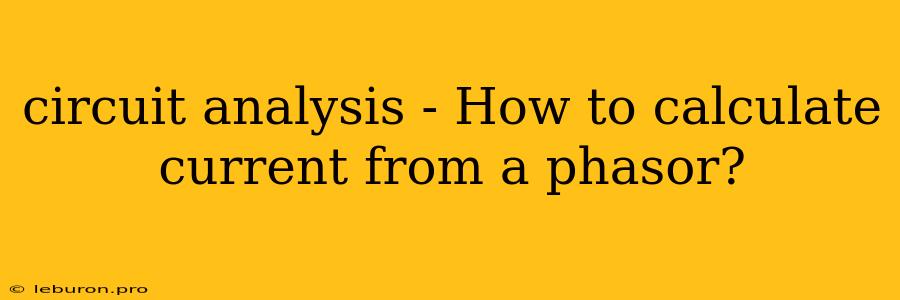Circuit analysis is a fundamental aspect of electrical engineering, dealing with the behavior of electrical circuits. Understanding how to calculate current from a phasor is crucial in circuit analysis, as phasors provide a convenient way to represent alternating current (AC) signals. This article will delve into the methods for calculating current from a phasor, providing a step-by-step guide to help you master this essential skill.
Understanding Phasors
A phasor is a complex number that represents a sinusoidal signal's amplitude and phase. It's a graphical tool used in circuit analysis to simplify the representation of AC signals. The magnitude of the phasor represents the amplitude of the signal, while the angle of the phasor represents the phase shift relative to a reference point.
Representing AC Signals with Phasors
The phasor representation of an AC signal is based on Euler's formula, which relates exponential functions to trigonometric functions.
Euler's formula:
- e^(jθ) = cos(θ) + jsin(θ)*
where:
- e is the base of the natural logarithm
- j is the imaginary unit, where j² = -1
- θ is the angle in radians
This formula allows us to express a sinusoidal signal as a rotating vector in the complex plane. The real component of the phasor represents the cosine component of the signal, while the imaginary component represents the sine component.
Calculating Current from a Phasor
The current phasor is a vector that represents the amplitude and phase of the current in an AC circuit. To calculate the current from a phasor, you need to know the impedance of the circuit element and the voltage phasor across that element.
Using Ohm's Law for Phasors
Ohm's law states that the voltage across a resistor is proportional to the current flowing through it. This relationship can be extended to AC circuits using phasors:
V = I * Z
Where:
- V is the voltage phasor
- I is the current phasor
- Z is the impedance of the circuit element
Calculating Current from Voltage and Impedance
To find the current phasor from the voltage phasor and impedance, we simply rearrange Ohm's law:
I = V / Z
Since both voltage and impedance are complex numbers, the division is performed using complex arithmetic.
Example: Calculating Current from a Phasor
Let's consider a circuit with a 100 Ω resistor and a voltage phasor of 10∠30° volts. To calculate the current phasor, we follow these steps:
- Determine the impedance: Since we have a resistor, the impedance is purely resistive and equal to 100 Ω.
- Divide the voltage phasor by the impedance:
- I = V / Z = (10∠30°) / 100 = 0.1∠30° amps
Therefore, the current phasor is 0.1∠30° amps. This means the current has a magnitude of 0.1 amps and is in phase with the voltage.
Applications of Current Calculation from Phasors
Understanding how to calculate current from a phasor has numerous applications in circuit analysis:
- Power calculations: The power consumed by a circuit element can be calculated using the current and voltage phasors.
- Circuit analysis: Phasor analysis allows you to analyze complex circuits with multiple components and determine the current and voltage at various points in the circuit.
- Filter design: Understanding the phase relationships between current and voltage is essential for designing filters that selectively pass or block specific frequencies.
- Power system analysis: Phasors are used in power system analysis to study the flow of power in AC transmission and distribution networks.
Conclusion
Calculating current from a phasor is a critical skill in circuit analysis. By understanding the principles of phasor representation and applying Ohm's law, you can effectively analyze AC circuits and determine the behavior of current and voltage signals. This knowledge is essential for a wide range of applications in electrical engineering and beyond.
